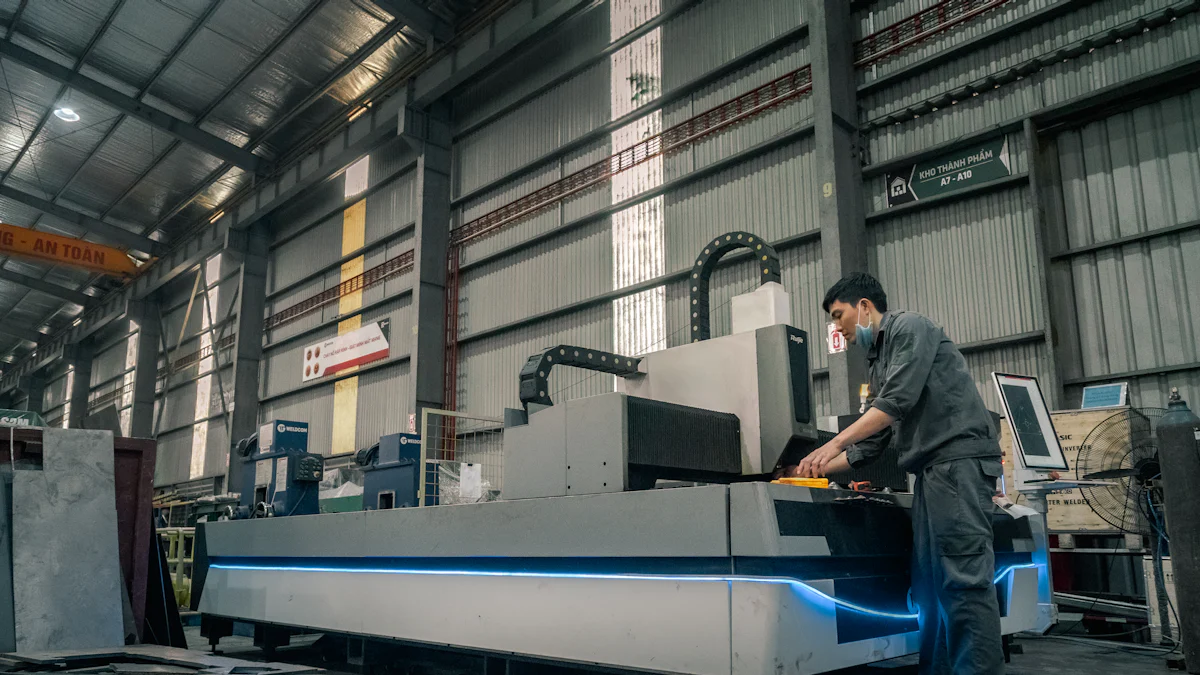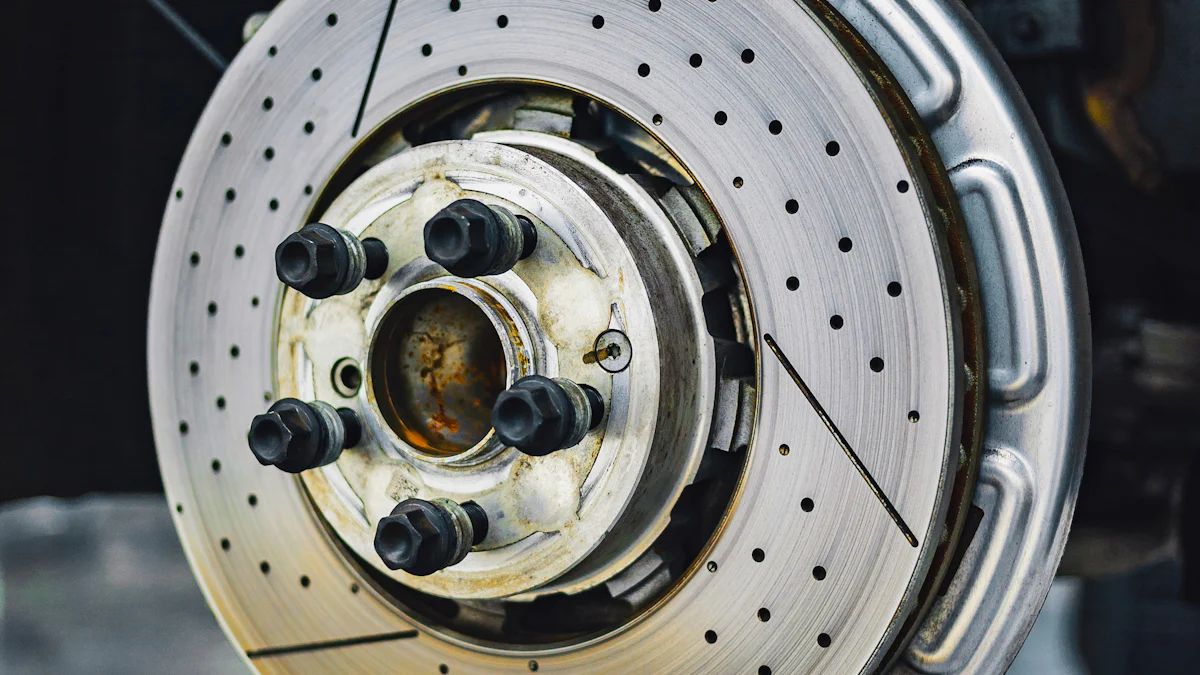
Silicon carbide (SiC) wafers have become pivotal in semiconductor technology due to their exceptional properties. These wafers, composed of silicon and carbon, offer superior thermal conductivity and mechanical strength, making them ideal for high-power applications. The SiC wafer market is experiencing rapid growth, with projections estimating a market size of USD 2.43 billion by 2029. Industries such as automotive and renewable energy increasingly rely on SiC wafers for their efficiency and durability. The use of SiC-coated graphite susceptors in manufacturing, along with traditional graphite susceptors, enhances the quality of these wafers, further solidifying their importance across various sectors. Additionally, the integration of wafer susceptors in the production process plays a crucial role in optimizing performance and ensuring the reliability of SiC wafers.
Key Takeaways
- SiC wafers are essential in semiconductor technology, offering superior thermal conductivity and mechanical strength for high-power applications.
- The automotive and renewable energy sectors are increasingly adopting SiC wafers due to their efficiency, leading to longer driving ranges for electric vehicles and improved energy conversion in renewable systems.
- SiC wafers outperform traditional silicon wafers by reducing energy consumption and enhancing device performance, making them ideal for demanding environments.
- The durability of SiC wafers ensures longevity in high-stress applications, reducing maintenance costs and enhancing reliability over time.
- Innovations in SiC technology are driving advancements in manufacturing processes, which may lower production costs and expand applications across various industries.
- Wafer susceptors play a critical role in the quality of SiC wafers, ensuring uniformity and stability during the manufacturing process, which is vital for achieving optimal performance…
Understanding SiC Wafers
What Are SiC Wafers?
Basic definition and composition
Silicon carbide (SiC) wafers are a type of semiconductor material composed of silicon and carbon atoms. These wafers exhibit unique properties that make them suitable for high-power and high-frequency applications. The crystalline structure of SiC provides exceptional thermal conductivity and mechanical strength, which are crucial for devices operating under extreme conditions. SiC wafers are available in various grades, including prime and research grades, to meet specific performance and cost requirements.
Historical development and evolution
The development of SiC wafers dates back to the early 20th century when researchers first synthesized silicon carbide crystals. Over the decades, advancements in crystal growth techniques have significantly improved the quality and size of SiC wafers. The introduction of 6-inch SiC wafers marked a significant milestone, driven by the demand for high-performance semiconductors in industries such as automotive, aerospace, and power electronics. Today, SiC wafers play a pivotal role in the evolution of semiconductor technology, enabling the development of efficient and reliable electronic devices.
Why Are SiC Wafers Important?
Role in semiconductor technology
SiC wafers have revolutionized semiconductor technology by offering superior performance in high-temperature and high-voltage environments. They are essential in the production of power electronic devices, such as Schottky diodes and metal-oxide-semiconductor field-effect transistors (MOSFETs). These devices benefit from the high thermal conductivity and durability of SiC, which allows them to operate efficiently in demanding applications like electric vehicles and renewable energy systems. The ability of SiC wafers to withstand high temperatures makes them ideal for high-speed and high-frequency operations.
Comparison with traditional silicon wafers
Compared to traditional silicon wafers, SiC wafers offer several advantages. They exhibit lower switching losses and improved efficiency, making them particularly beneficial for power electronics in electric vehicles. The hardness of silicon carbide, second only to diamond, enhances its effectiveness in high-performance electronic applications. While silicon wafers remain prevalent in many applications, the superior properties of SiC wafers drive their increasing adoption in industries requiring robust and efficient semiconductor solutions.
Properties of SiC Wafers
Physical Properties
Thermal conductivity
Silicon carbide (SiC) wafers exhibit exceptional thermal conductivity, a property that sets them apart in the semiconductor industry. This high thermal conductivity allows devices to operate efficiently at elevated temperatures without compromising performance. SiC wafers enable advanced power devices to dissipate heat effectively, ensuring stability and reliability in high-temperature environments. This characteristic proves crucial for applications in electric vehicles and renewable energy systems, where efficient heat management is essential.
Mechanical strength
The mechanical strength of SiC wafers contributes significantly to their durability and performance in demanding applications. Known for their hardness, second only to diamond, SiC wafers withstand mechanical stress and resist wear and tear. This robustness makes them ideal for high-stress environments, such as those found in automotive and aerospace industries. The ability to maintain structural integrity under extreme conditions enhances the longevity and reliability of devices utilizing SiC wafers.
Chemical Properties
Chemical stability
SiC wafers demonstrate remarkable chemical stability, a vital attribute for semiconductor materials. This stability ensures that SiC wafers maintain their properties and performance over time, even when exposed to harsh chemical environments. The resistance to chemical reactions makes SiC wafers suitable for applications in industries where exposure to corrosive substances is common. This property enhances the reliability and lifespan of electronic devices, contributing to their overall efficiency.
Resistance to harsh environments
The resistance of SiC wafers to harsh environments further underscores their suitability for advanced semiconductor applications. SiC wafers can endure extreme temperatures and pressures, making them indispensable in high-temperature and high-voltage applications. This resilience allows SiC wafers to perform reliably in challenging conditions, such as those encountered in power electronics and industrial motor drives. The ability to withstand such environments ensures that devices remain operational and efficient, even under the most demanding circumstances.
Benefits of Using SiC Wafers
Efficiency
Energy efficiency in electronic devices
Silicon carbide (SiC) wafers significantly enhance energy efficiency in electronic devices. Their superior thermal conductivity allows devices to operate at higher temperatures without compromising performance. This efficiency reduces energy consumption, making SiC wafers an ideal choice for applications requiring high power and minimal energy loss. Devices utilizing SiC wafers often exhibit lower switching losses compared to those using traditional materials, contributing to overall energy savings.
Performance improvements
SiC wafers offer remarkable performance improvements across various applications. Their ability to withstand high voltages and temperatures makes them suitable for demanding environments. SiC wafers excel in thermal and mechanical aspects, providing advantages beyond electrical properties. These characteristics enable devices to perform reliably under extreme conditions, enhancing their operational efficiency and effectiveness. The unique properties of SiC wafers drive their adoption in industries seeking robust and efficient semiconductor solutions.
Durability
Longevity in high-stress applications
The durability of SiC wafers ensures longevity in high-stress applications. Known for their exceptional mechanical strength, SiC wafers resist wear and tear, maintaining structural integrity over time. This robustness proves crucial in industries such as automotive and aerospace, where devices face extreme conditions. SiC wafers’ resistance to harsh environments further underscores their suitability for advanced semiconductor applications, ensuring devices remain operational and efficient even under the most demanding circumstances.
Cost-effectiveness over time
SiC wafers offer cost-effectiveness over time due to their durability and efficiency. While the initial investment may be higher compared to traditional materials, the long-term benefits outweigh the costs. Devices using SiC wafers often require less maintenance and have longer lifespans, reducing overall expenses. The enhanced performance and reliability of SiC wafers contribute to their cost-effectiveness, making them a valuable investment for industries seeking sustainable and efficient solutions.
Industrial Applications of SiC Wafers

Electronics Industry
Use in Power Electronics
Silicon Carbide (SiC) Wafers have revolutionized power electronics by offering superior performance and efficiency. Their unique properties, such as a wide bandgap and high thermal conductivity, enable devices to operate at higher voltages and temperatures. This makes SiC wafers indispensable in the development of advanced power electronic devices. These devices, including Schottky diodes and MOSFETs, benefit from the enhanced energy conversion capabilities of SiC wafers. As a result, industries can achieve greater efficiency and reliability in their power systems.
Impact on Consumer Electronics
In consumer electronics, SiC wafers contribute to the development of more efficient and compact devices. Their ability to handle high frequencies and temperatures allows for the creation of smaller, more powerful components. This leads to improved performance in everyday electronic devices, such as smartphones and laptops. The integration of SiC wafers in consumer electronics not only enhances device functionality but also extends their lifespan, providing users with more durable and reliable products.
Automotive Industry
Role in Electric Vehicles
The automotive industry has embraced SiC wafers for their role in electric vehicles (EVs). SiC-based power semiconductors offer significant advantages over traditional silicon devices, including lower switching losses and improved efficiency. These benefits translate into longer driving ranges and faster charging times for EVs. By utilizing SiC wafers, manufacturers can produce more efficient and reliable powertrains, contributing to the widespread adoption of electric vehicles.
Enhancements in Automotive Electronics
SiC wafers also play a crucial role in enhancing automotive electronics. Their ability to withstand high temperatures and voltages makes them ideal for applications such as onboard chargers and power inverters. These components are essential for the efficient operation of modern vehicles, ensuring optimal performance and safety. The use of SiC wafers in automotive electronics leads to more robust and efficient systems, ultimately improving the overall driving experience.
Energy Sector
Applications in Renewable Energy
In the energy sector, SiC wafers are pivotal in advancing renewable energy technologies. Their exceptional properties enable the development of efficient power devices for solar and wind energy systems. SiC-based components, such as inverters and converters, facilitate efficient energy conversion and distribution. This results in higher energy yields and reduced losses, making renewable energy systems more viable and sustainable.
Benefits in Power Generation and Distribution
SiC wafers offer significant benefits in power generation and distribution. Their high thermal conductivity and durability allow for the creation of robust power devices capable of operating under extreme conditions. This is particularly important in power generation facilities, where reliability and efficiency are paramount. By incorporating SiC wafers, the energy sector can achieve more efficient power generation and distribution, reducing costs and environmental impact.
Wafer Susceptor in SiC Wafer Manufacturing

Role of Wafer Susceptor
In the realm of semiconductor manufacturing, the wafer susceptor plays a pivotal role. This component is integral to the Metal Organic Chemical Vapor Deposition (MOCVD) process, which is crucial for producing high-quality silicon carbide (SiC) wafers. The wafer susceptor‘s primary function is to monitor and control key parameters during the MOCVD process, ensuring the growth quality and uniformity of the thin film. By maintaining precise conditions, the wafer susceptor contributes significantly to the overall efficiency and effectiveness of the manufacturing process.
Importance in Semiconductor Manufacturing
The importance of the wafer susceptor in semiconductor manufacturing cannot be overstated. It serves as the foundation upon which SiC wafers are formed, providing stability and uniformity throughout the deposition process. The susceptor’s ability to withstand high temperatures and maintain consistent thermal conductivity is essential for achieving the desired properties in SiC wafers. This ensures that the wafers meet the stringent requirements of various industrial applications, from power electronics to renewable energy systems.
Impact on SiC Wafer Quality
The quality of SiC wafers is directly influenced by the performance of the wafer susceptor. A well-designed susceptor ensures uniform temperature distribution across the wafer surface, which is critical for achieving consistent film thickness and composition. This uniformity leads to improved electrical and mechanical properties in the final product. Additionally, the susceptor’s material composition and design can impact the overall efficiency of the MOCVD process, further enhancing the quality of the SiC wafers produced.
Challenges and Future of SiC Wafers
Current Challenges
Manufacturing complexities
Manufacturing silicon carbide (SiC) wafers presents several challenges. The process requires precise control over crystal growth to ensure high-quality wafers. Manufacturers must maintain strict conditions during the production process to achieve the desired properties. This complexity often leads to longer production times and increased costs. Additionally, the need for specialized equipment and expertise further complicates the manufacturing process. These factors contribute to the challenges faced by the industry in scaling up production to meet growing demand.
Cost considerations
The cost of producing SiC wafers remains a significant challenge. The intricate manufacturing process and the need for high-quality raw materials drive up production costs. As a result, SiC wafers are often more expensive than traditional silicon wafers. This cost difference can deter some industries from adopting SiC technology, despite its advantages. However, as demand increases and production techniques improve, the industry expects costs to decrease over time. Companies must balance the initial investment with the long-term benefits of using SiC wafers in their applications.
Future Potential
Innovations in SiC technology
The future of SiC wafers looks promising, with ongoing innovations driving advancements in the field. Researchers continue to explore new methods for improving the quality and efficiency of SiC wafers. Innovations in crystal growth techniques and material processing hold the potential to enhance wafer performance and reduce production costs. These advancements will likely lead to the development of more efficient and reliable semiconductor devices. As technology evolves, SiC wafers will play an increasingly vital role in various industries.
Expanding applications across industries
SiC wafers have the potential to revolutionize multiple industries. Their unique properties make them suitable for a wide range of applications, from power electronics to renewable energy systems. As industries seek more efficient and sustainable solutions, the demand for SiC wafers will continue to grow. The automotive, aerospace, and energy sectors are just a few examples of industries that stand to benefit from the adoption of SiC technology. As applications expand, SiC wafers will become an integral part of modern technology, driving innovation and progress across various fields.
Silicon carbide (SiC) wafers stand at the forefront of semiconductor technology, offering unparalleled efficiency and performance. They play a crucial role in the development of electric vehicles, renewable energy systems, and advanced communication technologies. As industries seek more efficient solutions, SiC wafers present a formidable alternative to traditional silicon wafers. Their unique properties make them indispensable components in the semiconductor industry. The potential for future advancements and applications remains vast. Continued exploration and investment in SiC wafer technology will drive innovation and progress across various fields.
FAQ
What are the advantages of SiC wafers over silicon wafers?
Silicon carbide (SiC) wafers provide superior performance and efficiency compared to traditional silicon-based devices. Their unique properties, such as a wide bandgap, high breakdown electric field, and high thermal conductivity, make them ideal for high-power and high-temperature applications. These characteristics enable SiC wafers to operate efficiently in demanding environments, offering significant advantages in power electronics and renewable energy systems.
How do SiC wafers contribute to energy efficiency in electronic devices?
SiC wafers enhance energy efficiency by allowing electronic devices to operate at higher temperatures without compromising performance. Their superior thermal conductivity reduces energy consumption, making them an ideal choice for applications requiring high power and minimal energy loss. Devices utilizing SiC wafers often exhibit lower switching losses, contributing to overall energy savings.
Why are SiC wafers important in the automotive industry?
In the automotive industry, SiC wafers play a crucial role in electric vehicles (EVs) and automotive electronics. SiC-based power semiconductors offer lower switching losses and improved efficiency compared to traditional silicon devices. This results in longer driving ranges and faster charging times for EVs. Additionally, SiC wafers enhance the performance of onboard chargers and power inverters, ensuring optimal vehicle operation.
What role do SiC wafers play in renewable energy systems?
SiC wafers are pivotal in advancing renewable energy technologies. Their exceptional properties enable the development of efficient power devices for solar and wind energy systems. SiC-based components facilitate efficient energy conversion and distribution, resulting in higher energy yields and reduced losses. This makes renewable energy systems more viable and sustainable.
How do SiC wafers withstand harsh environments?
SiC wafers demonstrate remarkable resistance to harsh environments due to their chemical stability and mechanical strength. They can endure extreme temperatures and pressures, making them indispensable in high-temperature and high-voltage applications. This resilience ensures that devices remain operational and efficient, even under the most demanding circumstances.
What challenges exist in the manufacturing of SiC wafers?
Manufacturing SiC wafers presents several challenges, including the need for precise control over crystal growth to ensure high-quality wafers. The process requires strict conditions and specialized equipment, leading to longer production times and increased costs. These complexities contribute to the challenges faced by the industry in scaling up production to meet growing demand.
What is the future potential of SiC technology?
The future of SiC technology looks promising, with ongoing innovations driving advancements in the field. Researchers continue to explore new methods for improving the quality and efficiency of SiC wafers. Innovations in crystal growth techniques and material processing hold the potential to enhance wafer performance and reduce production costs. As technology evolves, SiC wafers will play an increasingly vital role in various industries.
How do SiC wafers impact consumer electronics?
In consumer electronics, SiC wafers contribute to the development of more efficient and compact devices. Their ability to handle high frequencies and temperatures allows for the creation of smaller, more powerful components. This leads to improved performance in everyday electronic devices, such as smartphones and laptops, enhancing device functionality and extending their lifespan.
What is the significance of wafer susceptors in SiC wafer manufacturing?
Wafer susceptors play a pivotal role in the Metal Organic Chemical Vapor Deposition (MOCVD) process, crucial for producing high-quality SiC wafers. They monitor and control key parameters during the process, ensuring the growth quality and uniformity of the thin film. This contributes significantly to the overall efficiency and effectiveness of the manufacturing process, impacting the quality of the final SiC wafers.